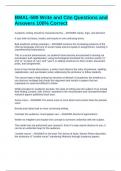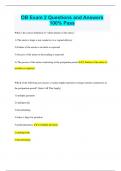BMAL-590 Write and Cite Questions and
Answers 100% Correct
Academic writing should be characterized by: - ANSWER-clarity, logic, and direction
It sets forth its theory, model, and results in non-confusing terms.
Bad academic writing examples: - ANSWER-involves the increasing presence of the
informal language and tone of social media and text speak in assignments, resulting in
unprofessional submissions.
This is a recent phenomenon, as students have become accustomed to leaving out
punctuation and capitalization, using technological shorthand for common words ("u"
and "ur" in place of "you" and "your") or adding emoticons to their emails, discussion
posts, and assignments.
Even in less formal discussions, a writer must observe the rules of grammar, spelling,
capitalization, and punctuation when addressing the professor or fellow students.
The second type of bad writing has become a hallmark of academia: the tendency to
use obscure verbiage that clouds the argument and results in papers that are
unpleasant to read and difficult to follow.
While prevalent in academic journals, this style of writing was the subject of an annual
Bad Writing Contest, with "prizes" awarded to the most bloated and incomprehensible
research papers published each year.
Active voice: - ANSWER-The active voice is more direct and concise than the passive
voice.
Brevity and clarity lead to more convincing writing.
Consider the audience. Good papers are: - ANSWER-Devoid of egocentrism.
Written to enlighten and explain the concept to someone unfamiliar with the subject.
The reader has not performed your research. Even if a step seems obvious to you, it
can be an unfamiliar leap for the audience.
"zombie nouns" - ANSWER-In his book The Sense of Style, Steven Pinker describes
the existence of "zombie nouns" wandering lifelessly through academic papers.
,They are ambiguous nouns taking the place of more active verbs, and using them
makes an idea more abstract.
Instead, use active verbs:
Affirming an idea
Postponing an event
Rather than nominalizations:
Effect its affirmation
Implement a postponement
Certainty - ANSWER-Do not weaken your writing by hedging.
The use of qualifiers lends doubt to your writing.
Strike any words that do not enhance the understanding of the subject.
Explain with examples:
Identify the type of writing error in the following sentence: The reduction in hostilities by
the rebel forces resulted in the ratification of a peace treaty by the government. -
ANSWER-Zombie nouns. Turning active verbs into awkward adjectives makes ideas
more abstract
A more direct version would read, "Rebel forces reduced hostilities, and in turn the
government ratified the peace treaty."
Identify the type of writing error in the following sentence: A rising awareness of the
dichotomous nature of the current political paradigm shift manifests itself in a societal
entropy that resists efforts to promote bilateral coalescence. - ANSWER-Lacks clarity.
Using a pretentious tone confuses the audience; choose words that enlighten the
reader.
Technical terms without explanation confuse the reader.
To paint a clear picture, make liberal use of the phrases as in, such as, or for example.
If technical terms are unavoidable, use the ones most understandable to the reader.
References - ANSWER-Unsupported statements do not belong in academic writing.
No argument, however logical, can be taken as a given premise.
Include the appropriate reference to back up each stage of your writing, making a clear
path to the conclusion.
,Identify the type of writing error in the following sentence: The delay in the ceremony's
commencement was caused by a sudden downpour on the front lawn. - ANSWER-
Passive voice. Use the active voice for direct, concise writing.
Identify the type of writing error in the following sentence: I agree with your discussion
post its alot harder to fix human resource problems when they're aren't any systems in
place. - ANSWER-Incorrect grammar or punctuation. All academic writing must adhere
to the rules of grammar, spelling, capitalization, and punctuation.
Identify the type of writing error in the following sentence: The validation-seeking
approach employed by many social media users can lead to the alienation of others in
the social circle. - ANSWER-Zombie nouns. Turning active verbs into awkward
adjectives makes ideas more abstract.
Identify the type of writing error in the following sentence: The results seem to indicate
that there could be a minor shift in the way social media is used in organizations. -
ANSWER-Hedging. Qualifiers lend doubt to your writing. Strike extra words that do not
contribute meaning.Correct!
Omit the qualifiers for stronger writing: "The results indicate a shift in the way social
media is used in organizations."
This sentence is an example of academic narcissism. Good academic writing aims to
explain, not impress.
Step 1-State in the introduction of your work what the specific research problem is: -
ANSWER-The reader should not have to guess where your thoughts may lead. Your
paper is not a mystery novel
- point the reader toward the conclusion from the introduction.
A convincing research paper will provide a clear, logical path toward the intended
destination.
Step 2-Explain why the research problem is important: - ANSWER-The problem's
importance is not determined by personal interest in the subject; rather, it is a reflection
on a specific need not addressed by other studies done on the subject.
The research problem must consider current studies and build upon them to contribute
to knowledge in the field.
Step 3-Define what is currently known about the problem: - ANSWER-Include
summaries and critiques of existing studies.
, Help the reader understand the limitations of current knowledge and the possible
contribution of your research.
Step 4-Show what your work will add to the field of study on the topic: - ANSWER-
Introduce your hypothesis and objectives, but avoid any conclusive statements before
presenting the argument.
Consider both competing and concurring theories in your field, and the possible
contribution of your research.
Think of your research as a bridge taking the reader from what is known on the topic to
a new area of discovery.
Once you have defined the research problem with the 4 introductory steps, you will add
sections for: - ANSWER-Method
Results
Discussion
Method: - ANSWER-This is the section where you describe the procedures used to
perform the study.
Use clear, informative sentences to set forth the steps taken to conduct your research.
Include all relevant elements: participants or models and how they were chosen, the
means of collecting and measuring data, and the plan for analysis.
Results: - ANSWER-This is the section where you explain the findings.
In this section, you take the research notes and share with the reader the outcomes you
observed.
In addition to reporting the results, you will analyze them and explain them in context of
the problem.
Discussion: - ANSWER-This is the summary, with interpretation of your results and how
they may support or contradict other studies.
You will discuss the implications of your research and any changes it makes to current
knowledge in the field.
Conclusion: - ANSWER-should answer questions posed in the introduction, and take
them one step further.
This is the part where you tie together the information gathered with results of other
studies, and describe how they fill the void of current knowledge and what remains to be
studied. The conclusion unites all elements of the research problem.





